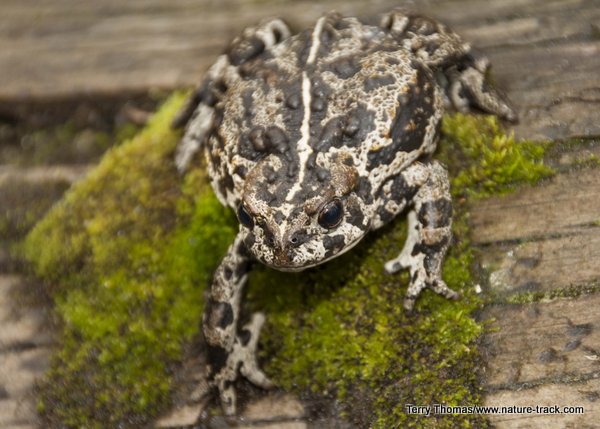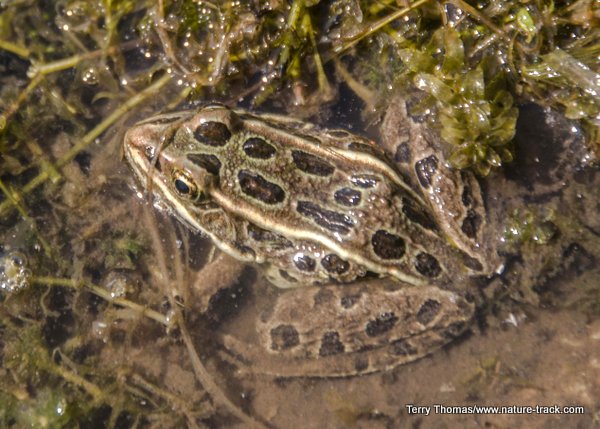Frogs and Toads


The western toad (left) and the leopard frog are cousins, but live very different lifestyles.
It started out as a single guttural low call, one that immediately had us reaching for our phones to identify it. We were birding at Patagonia Lake in southeast Arizona last week, and since we were birding, we assumed the strange noise was a bird. But as we tested bird after bird, none of them had a call that matched the sound. Bittern? Nope. Green heron? Not even close. Then we heard another and then another and soon a whole chorus and my wife exclaimed, bull frogs! We had never heard bull frogs before but determined that the makers of this strange sound, one that sounded like electrical humming late in the evening, were frogs, not birds.
Frogs and toads are probably the most ubiquitous members of the amphibian world. But what is the difference between the two? They are similar in basic configuration. Frog is the description of a specialized animal with specific characteristics including: no discernable neck (only ten vertebrae compared to an adult human’s 24 vertebrae), a broad head and no tail as adults. They are amphibians, not reptiles, and can breathe through their skin.
Both frogs and toads go through a complete metamorphosis where they change from one lifeform to a completely different one, but their differences start here. They begin life as a fertilized egg, part of a mass of similar eggs, laid in shallow pools in a cluster (frogs) or in a long chain (toads). Frog tadpoles are usually slender and golden brown while toad tadpoles are black and plump.
As they mature into adults, more differences manifest themselves. Most noticeable might be in how they each move. Toads move relatively slowly, almost crawling on short hind legs, rarely jumping. On the other hand, frogs, with their long sleek legs, jump regularly as a form of locomotion and can sometimes leap impressive distances. In addition, frog feet are usually webbed between the toes and those of toads are not webbed.
This webbing or lack thereof also indicates a lifestyle. Frogs are highly aquatic, living in and around water all the time. Toads spend much more of their time on land where webbed feet would be a hinderance.
Just looking at a frog in one hand and a toad in the other will show you a couple of other distinct differences. First, the frog’s skin is smooth and glistening, appearing wet. That of a toad is coarse and “warty” with a dry appearance. In addition, the toad is stubby and thick, sometimes almost round in shape where a frog is often more “athletic-looking”.
But enough of the differences. Frogs and toads are members of the same family and are closely related. Scientists do not distinguish between frogs and toads taxonomically. One source I read stated that all toads are frogs, but not all frogs are toads. They went on to explain that most frogs have teeth, small to be sure, and only on the upper jaw and sometimes on the tongue and/or palate, but toads do not. That is the real distinction as there are frog and toad species that sometimes cross the other lines.
Frogs may have been on this planet for 265 million years. Whether it is the smallest frog of just one-third of an inch long, or the largest, at 13 inches and seven pounds, they are successful enough to have remained unchanged for most of that time. Sadly, over 120 species of frogs are thought to have become extinct in the past 40 years with another one third of species considered threatened with extinction. Our watch may be the one to witness the demise of one of the most successful groups of species the world has ever known.
Help Idaho Wildlife
When we traveled across the state in October 2017, most of the vehicles we saw using the wildlife management areas did not have wildlife plates. Buying wildlife plates is a great way for non-hunters and hunters alike to support wildlife-based recreation like birding.
C'mon folks, let's help Idaho's wildlife by proudly buying and displaying a wildlife license plate on each of our vehicles!
See below for information on Idaho plates. Most states have wildlife plates so if you live outside Idaho, check with your state's wildlife department or vehicle licensing division for availability of state wildlife plates where you live.
And tell them that you heard about it from Nature-track.com!

Wildlife License Plates
Great news! as of 2024, there are three NEW designs for license plates. They still are bluebird, cutthroat trout and elk, but they are beautiful.
Idaho Wildlife license plates provide essential funding that benefits the great diversity of native plants and wildlife that are not hunted, fished or trapped—over 10,000 species or 98% of Idaho’s species diversity. Game species that share the same habitats (such as elk, deer, antelope, sage-grouse, salmon, trout) also benefit from these specialty plates.
No state tax dollars are provided for wildlife diversity, conservation education and recreation programs. Neither are any revenues from the sale of hunting or fishing licenses spent on nongame species. Instead, these species depend on direct donations, federal grants, fundraising initiatives—and the Idaho Wildlife license plates.
Both my vehicles have Bluebird Plates. I prefer the bluebird because the nongame program gets 70 percent of the money from bluebird plates, but only 60 percent of the money from elk and trout plates - 10 percent of the money from elk plates supports wildlife disease monitoring and testing programs (to benefit the livestock industry) and 10 percent from cutthroat plates supports non-motorized boat access.
Incidentally, in 2014, the Idaho Legislature denied the Department of Fish and Game the ability to add new plates or even to change the name of the elk and cutthroat plates (very specific) to wildlife and fish plates, a move that would have allowed for changing images occasionally and generating more revenue. It would seem that they believe that we Idahoans don't want a well funded wildlife program.
I think it is time we let the Legislature know that Idahoan support wildlife funding and that we would like to see these generic plates come to fruition.

"WOW. What a phenomenal piece you wrote. You are amazing." Jennifer Jackson
That is embarrassing, but actually a fairly typical response to my nature essays. Since The Best of Nature is created from the very best of 16 years of these nature essays published weekly in the Idaho Falls Post Register (online readership 70,000), it is a fine read. It covers a wide variety of topics including humorous glimpses of nature, philosophy, natural history, and conservation. Readers praise the style, breadth of subject matter and my ability to communicate complex and emotional topics in a relaxed and understandable manner.
Everyone can find something to love in this book. From teenagers to octogenarians, from the coffee shop to the school room, these nature essays are widely read and enjoyed.
Some of the essays here are my personal favorites, others seemed to strike a chord with readers. Most have an important message or lesson that will resonate with you. They are written with a goal to simultaneously entertain and educate about the wonderful workings of nature. Some will make you laugh out loud and others will bring a tear to the eye and warm your heart.
Readers Write:
"You hit a home run with your article on, Big Questions in Nature. It should be required reading for everyone who has lost touch with nature...great job!" Joe Chapman
"We enjoyed your column, Bloom Where Planted. Some of the best writing yet. The Post Register is fortunate to have your weekly columns." Lou Griffin.
To read more and to order a copy, click here or get the Kindle version
Copies are also available at:
Post Register
Island Park Builders Supply (upstairs)
Barnes and Noble in Idaho Falls
Harriman State Park, Island Park
Museum of Idaho
Valley Books, Jackson Wyoming
Avocet Corner Bookstore, Bear River National Wildlife Refuge, Brigham City, Utah
Craters of the Moon National Monument Bookstore, Arco, Idaho